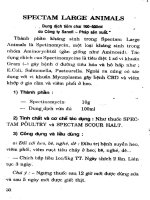- Trang chủ >>
- Khoa Học Tự Nhiên >>
- Vật lý
Applied Clay Mineralogy Phần 3 docx
Bạn đang xem bản rút gọn của tài liệu. Xem và tải ngay bản đầy đủ của tài liệu tại đây (1.23 MB, 19 trang )
Some common clays are used as a raw material in the mix to make
cement. In this use, the chemical composition is important, particularly
the alumina and silica values.
REFERENCES
Bailey, S.W. (1980) Structures of layer silicates. Chapter 1 in Crystal Structures
of Clay Minerals and their X-Ray Identification. Brindley, G.W. and Brown,
G., eds. Mineralogical Society Monograph No. 5, London, pp. 1–123.
Bailey, S.W. (1988) Chlorites: structures and crystal chemistry. Chapter 10
in Hydrous Phyllosilicates. Bailey, S.W., ed. Reviews in Mineralogy Vol. 19,
pp. 347–403.
Table 9. Properties necessary to make lightweight aggregate
Chemical and mineralogical composition
Temperature at which gases are evolved
Vitrification range and temperature
Fired specific gravity (this use will be discussed in Chapter 8)
Fig. 19. Rileys (1951) diagram showing the relationship of chemistry and bloating to
produce a lightweight aggregate.
Applied Clay Mineralogy30
Bailey, S.W. (1993) Review of the structural relationships of the kaolin minerals.
Chapter in Kaolin Genesis and Utilization. Murray, H., Bundy, W., and
Harvey, C., eds. Special Publication No. 1. The Clay Minerals Society,
Boulder, CO, pp. 25–42.
Bates, T.F., Hildebrand, F.A., and Swineford, A. (1950) Morphology and
structure of endellite and halloysite. Am. Mineral., 35, 463–484.
Grim, R.E. (1962) Applied Clay Mineralogy. McGraw-Hill, New York, 422pp.
Grim, R.E. (1968) Clay Mineralogy, 2nd Editio n. McGraw-Hill, New York,
596pp.
Grim, R.E., Bray, R.H., and Bradley, W.F. (1937) The mica and argillaceous
sediments. Am. Mineral., 22, 813–829.
Grim, R.G. and Guven, N. (1978) Bentonites—Geology, Mineralogy, Properties
and Uses. Elsevier, Amsterdam, 256pp.
Guven, N. (1988) Smectites. Chapter 13 in Hydrous Phyllosilicates. Bailey, S.W.,
ed. Reviews in Mineralogy Vol. 19, pp. 497–559.
Jepson, W.B. and Rowse, J.B. (1975) The composi tion of kaolinite—an electron
microscope microprobe study. Clay. Clay Miner., 23, 310–317.
Johnson, C.T., et al. (2000) Distribution of dickite and nacrite stacking se-
quences in kaolin (Abstract). Clay Minerals Society, 37th Annual Meeting,
Loyola University, Chicago, IL, p. 69.
Jones, B.F. and Galan, E. (1988) Sepiolite and palygorskite. Chapter 16 in
Hydrous Phyllosilicates. Bailey, S.W., ed. Reviews in Mineralogy Vol. 19,
pp. 631–674.
Keller, W.D. (1982) Applications of scanning electron microscopy to clays and
other fine-grained minerals. Proceedings Process Mineralogy II. Hagni, R.D.,
ed. Metallurgical Society, AIME, pp. 245–261.
Mason, B.H. (1994) Lightweight aggregate. Chapter in Industrial Minerals and
Rocks, 6th Edition. Carr, D.D ., ed. Society for Mining, Metallurgy and
Exploration, Littleton, CO, pp. 343–350.
Moore, D.M. and Reynolds, R.C. Jr. (1997) X-Ray Diffraction and the Iden-
tification and Analysis of Clay Minerals, 2nd Edition. Oxford University
Press, Oxford and New York, 378pp.
Murray, H.H. (1994) Common clay. Chapter in Industrial Minerals and Rocks,
6th Edition. Carr, D.D., ed. Society for Mining, Metallurgy and Exploration,
Littleton, CO, pp. 247–248.
Murray, H.H. and Smith, J.M. (1958) Lightweight Aggregate Potentialities of Some
Indiana Shales. Indiana Geological Survey Report of Progress No. 12, 42pp.
Newman, A.C.D., ed. (1987) Chemistry of Clays and Clay Minerals. Minera-
logical Society Monograph No. 6, London, 480pp.
Riley, C.M. (1951) Relation of chemical properties to the bloating of clays. J.
Am. Ceram. Soc., 34, 121–128.
Robertson, R.H.S. (1986) Fuller’s Earth—A History. Volturna Press, Hythe,
Kent, UK, 421pp.
Ross, C.S. and Shannon, E.V. (1926) Minerals of bentonite and related clays
and their physical properties. J. Am. Ceram. Soc., 9, 77–96.
Weaver, C.E. (1976) The nature of T
i
O
2
in kaolinite. Clay. Clay Miner., 24,
215–218.
Chapter 2: Structure and Composition of the Clay Minerals 31
This page intentionally left blank
Chapter 3
GEOLOGY AND LOCATION OF MAJOR INDUSTRIAL
CLAY DEPOSITS
There are many clay deposits around the world that are mined and
processed for industrial uses. However, in this chapter, only the major
world-class deposits of kaolins (including halloysite and ball clay), bent-
onites, and palygorskite–sepiolite that are marketed regionally or world-
wide are described.
1. KAOLINS
1.1. United States
The sedimentary kaolins in Georgia and South Carolina have been uti-
lized since the middle 1700s. The total tonnage mined to date from this
area is over 500,000,000 tons. This region is one of two of the most
extensive areas of secondary kaolin deposits in the world. These kaolins
occur as Late Cretaceous and Early Tertiary age lenses and beds which
were derived from weathered granites, gneisses, and phyllites on the
Piedmont Plateau (Fig. 20). In Late Cretaceous time, the residual weath-
ering products of granites and gneisses were eroded and transported to
the coastline located along what is known as the fall line. The fall line is
the boundary between the crystalline rocks of the Piedmont Plateau and
the Coastal Plain sediments to the southeast (Fig. 20). These detrital
weathering products were deposited in lagoons, estuaries, oxbows, lakes,
and ponds in a broad deltaic system covering an area about 30–50 km
wide and 150 km long extending from Macon, Georgia to Aiken, South
Carolina (Kogel et al., 2002). The kaolin beds range from 2 to 12 m thick.
The Tertiary kaolins are generally larger in areal extent and thicker than
the Cretaceous kaolins (Murray and Keller, 1993).
The Cretaceous kaolins are relatively coarse with a particle size rang-
ing from 55% to 75% o2 mm. They are often referred to as soft kaolins.
The Tertiary kaolins are much finer with a particle size finer than about
85% o2 mm or finer and are called hard kaolins. In the book by Kogel
et al., (2002), the typical properties of the soft and hard kaolins are
33
summarized. Fig. 21a, b shows typical electron micrographs of a soft
Cretaceous kaolin and a hard Tertiary kaolin. The soft kaolins contain a
large quantity of coarse stacks interspersed in a matrix of finer platy
particles. The hard kaolins contain thin platy particles with no large
books or stacks (Murray and Keller, 1993). The Hinckley index of
crystallinity (Hinckley, 1963) is high for the soft kaolins and low for the
hard kaolins. Dombrowski (1993) reviewed the theories for the origin of
the Cretaceous soft kaolins and the Tertiary hard kaolins. His research
showed that the Cretaceous kaolins were derived from granites and
gneisses and the Tertiary kaolins were derived from phyllite source ma-
terial. These results were based on trace element geochemistry.
Kaolinite is the dominant mineral present in these Georgia and South
Carolina kaolins, generally comprising more than 90% of the mineral
content (Murray, 1976). Other accessory minerals that are commonly
present include quartz, muscovite, biotite, partially altered feldspar, and
smectite along with minor amounts of halloysite, magnetite, ilmenite,
rutile, anatase, zircon, tourmaline, and a few other heavy minerals pre-
viously enumerated in Chapter 1. The current annual production is about
7,400,000 tons as estimated by the US Geological Survey (Virta, 2004).
1.2. England
The largest and highest quality primary kaolin deposits in the world are
located in Cornwall and Devon in southwestern England (Fig. 22). These
Fig. 20. Location map of kaolins in Georgia and South Carolina.
Applied Clay Mineralogy34
kaolins were discovered in 1746 (Wilson, 2002). Wilson estimates that the
total production since their discovery has been about 170,000,000 tons.
The kaolinite is derived from late stage magmatic or hydrothermal de-
composition of feldspar in the granite (Bristow, 1993). The kaolinite
content in the altered granite ranges between 10% and 20%. Extensive
drilling has shown that the typical kaolin body is funnel- or trough-like in
form (Fig. 23). Dewu and Durrance (1993) have shown that uranium is
the main source of radiogenic heat that has resulted in a hydrothermal
circulation system which is an on-going process that is still actively
forming kaolinite within the granites. Two distinct types of kaolinite
occur in the granites: a fine platy type and a vermiform type (Wilson,
Fig. 21. Scanning electron micrograph of (a) a soft Cretaceous Georgia kaolin and (b) a
hard Tertiary Georgia kaolin.
Chapter 3: Geology and Location of Major Industrial Clay Deposits 35
2002). The fine platy kaolinite is associated with feldspar and the ver-
miform kaolinite is derived from muscovite. Because of the low iron
content of the parent granite, the recovered kaolinite is very white. The
current annual production is about 2,000,000 tons (Wilson, 2002).
Fig. 22. Kaolin deposits in southwestern England.
Fig. 23. Typical shape of the hydrothermal English kaolin deposits.
Applied Clay Mineralogy36
1.3. Brazil
TheAmazonregioninnorthernBrazilhastwoareaswheresedimentary
kaolins are mined and processed primarily for use by the paper industry
(F ig. 24). The first area o n the Jari River, a t ributary of th e Amazon, was
discovered in 1970. The kaolin in this large deposit is Pliocene in age and is
called the Belterra clay (Murray, 1981). The extent of this deposit is 12 km in
length and 5 km in width and is up to 40 m thick. The top 8 m of the kaolin
is laterized and contains considerable gibbsite. The kaolin below the laterite
is very fine, normally at least 90% o2 mm, so is a hard kaolin in which the
kaolinite particles are small plates with no bo oks or stacks (Fig. 25). The
kaolin occurs near the top of the Barreiras series (Fig. 26), and is located on
a plateau on the east side of the Jari River. This plateau is dissected by
several streams and is overg rown with a dense tropica l forest. The elevation
of the plateau is about 150 m above the Jari River. The source of the
Belterra kaolin was from the crystalline rocks on the Guyana Shield about
15 km north (Murray and Partridge, 1982). The current annual production
of this Jari kaolin is about 850,000 tons (Franca, 2002).
The second area where sedimentary kaolins are being mined and
processed is along the Capim River south of Belem in the state of Para
(Fig. 24). This Capim basin is located between the 21 and 31 parallels and
the 471 and 481 meridians just south of the equator. The kaolin layers
occur in the Ipixuna Formation of Tertiary age (Fig. 27). The kaolin
Fig. 24. Location of kaolin mines and plants in northern Brazil.
Chapter 3: Geology and Location of Major Industrial Clay Deposits 37
deposits are found in low, slightly elevated plateaus with dissected edges
which have very little regional expression and are somewhat difficult to
distinguish (Alves, Personal communication). These low lying plateaus
range from 2 to 3 km in length and width and show a difference in
elevation of 30–60 m above sea level. In the basin there are two layers of
kaolin, a lower layer of relatively coarse kaolin and an upper layer of fine
kaolin. The lower layer is a soft kaolin with a particle size of 50–65%
o2 mm. This kaolin is well crystallized and electron micrographs show
many large stacks in a matrix of fairly large plates (Fig. 28). There is a
relatively low percentage of particles that are o0.5 mm which is a major
difference from the soft Cretaceous age kaolins from Georgia. The upper
kaolin layer is much finer with a particle size of 85% o2 mm or more.
Fig. 29 is an electron micrograph of the hard kaolin which shows that the
particles are very fine and appear to be somewhat rounded. The proven
reserves in the Capim basin are well over 500,000,000 tons (Alves, Per-
sonal communication). Currently, there are two operating mines which
are producing a total annual tonnage of 1,600,000 tons. The quality of
the Capim kaolins is very good. The kaolin is mined and partially proc-
essed at the mine sites and is then transported through pipelines to
Barcarena, a port on the Guama River, a large tributary of the Amazon
(Fig. 24), where the kaolin is prepared for slurry or dry shipment.
Fig. 25. Scanning electron micrograph of the Jari kaolin.
Applied Clay Mineralogy38
1.4. Czech Republic
The kaolin deposits in the Czech Republic are mainly residual deposits
which were formed by weathering of granites in the Karlovy Vary region
(Fig. 30). Also, a carboniferous arkose in the Podborany area has been
Fig. 26. Stratigraphic column of Pliocene Barreiras series.
Fig. 27. Stratigraphic column showing the Ipixuna Formation.
Chapter 3: Geology and Location of Major Industrial Clay Deposits 39
kaolinized by residual weathering (Kuzvart, 1984). The largest deposit is
located between Podborany and Krasny Dvur and contains over 100 mil-
lion tons of reserves (Aron, 2000). The average thickness of this deposit is
30 m. In the Karlovy Vary area, there is a large pluton called the western
Krusne Hory Pluton, which is comprised of lithium micaceous granites.
These granites are highly jointed and faulted so that surface residual
Fig. 28. Scanning electron micrograph of the soft Capim basin kaolin.
Fig. 29. Scanning electron micrograph of the hard Capim basin kaolin.
Applied Clay Mineralogy40
kaolinization can be very deep (Krelina et al., 1982). The principal peak
of climatic kaolinization took place in Cretaceous and Paleocene times
(Neuzil and Konta, 1965). Zettlitz kaolin has been supplied to the por-
celain and ceramics industries in Europe since 1805. The original Zettlitz
deposit near the village of Sedlec was abandoned in 1962. However, other
primary deposits in the area are similar in quality and now are used to
supply Zettlitz kaolin primarily to ceramic customers. The annual pro-
duction of washed kaolin from the Czech Republic is estimated to be
750,000 tons (Wilson, 2002).
1.5. Indonesia
Kaolin is mined on the islan d of Belitung and B angka located in the Java
Sea north of Jakarta (Fig. 31). The majority of the mining is on Belitung.
The kaolins there are residual and alte red from porphyr itic granite
(Murray et al., 1978). The mineralogical and chemical changes in the
altered granite from the surface down to the fresh granite show that the
feldspars alter to kaolinite a nd halloysite; the biotite a lters to hydro biotite
andthentovermiculitefollowedbysmectite; and the quartz is unaltered
except for solution pitting. The kaolin which is mined is comprised of ver-
micular kaolinite stacks, and plates along with some halloysite (Fig. 32).
The granite which is altered to kaolinite underlies the northwest quar-
ter of the island (about 625 km
2
) and is Triassic in age. Since Cretaceous
time, the area has been very stable so that intensive tropical weathering
altered the granite to depths averaging about 8 m. This residual kaolin
Fig. 30. Location of kaolin deposits in the Czech Republic near Karlovy Vary.
Chapter 3: Geology and Location of Major Industrial Clay Deposits 41
Fig. 31. Location of Bangka and Belitung where kaolin deposits occur.
Fig. 32. Scanning electron micrograph of Belitung kaolin.
Applied Clay Mineralogy42
has a low iron and titanium content, so has a relatively high brightness.
The kaolin is used locally as a ceramic raw material and is shipped to
Japan, the Philippines, and Taiwan, where it is used as a filler in paper.
Because of the halloysite and smectite content, the viscosity is high so it is
not useable as a paper coating clay. Wilson (2002) estimated the current
annual production at 500,000 tons.
1.6. China
There are many primary kaolin deposits in China, the largest of which is a
hydrothermal deposit at Suzhou. Suzhou is located southwest of Shanghai
in Jiangsu Province (Fig. 33). The kaolin is altered from Jurassic age
volcanics. The Suzhou deposits are very complex because of the diverse
parent rocks, geologic structures, and the hydrothermal and groundwater
leaching (Zheng Zhi et al., 1982). The kaolinized zone averages 20 m in
thickness and is comprised mainly of kaolinite, halloysite, and quartz,
along with minor amounts of smectite, sericite, alunite, and pyrite. The
Suzhou kaolin is used as a ceramic raw material and a filler in paper and
Fig. 33. Location of Suzhou and Maoming kaolin deposits.
Chapter 3: Geology and Location of Major Industrial Clay Deposits 43
rubber and an extender in paint. Other primary kaolins in China are used
locally mainly as a ceramic raw material.
The only large sedimentary deposit in China is located near Maoming in
western Guandong Province (Fig. 33). This kaolin is actually a kaolinitic
sand of Late Tertiary age. The Bureau of Geology and Mineral Resources of
Guandong estimated the kaolin reserves in this large kaolinitic sand are over
200 million tons. The kaolinitic sand body ranges from 20 to 45 m in thick-
ness and e xtends h orizontally for about 50 km ( Yuan and Murray, 1993).
The mineral content of this large Tertiary body is 75–80% quartz and
20–25% kaolinite. The genesis of the Maoming kaolin is attributed to in situ
alteration of feldspar in an original arkosic sand. The arkosic rocks were
derived from intensive weathering of Precambrian gneisses and Cretaceous
acidic igneous rocks which were transpo rted a short distance and depo sited
in the Maoming sedimentary basin (Lin et al., 1989). The kaolinite recovered
from the friable kaolinitic sand has a particle size of 95% finer than 10 mm
and 60% finer than 2 mm(Yuan, 1994). The kaolinite particles are platy and
have a sharp pseudo-hexagonal morphology. This kaolin is used as a ce-
ramic raw material and as a filler and coating clay for paper. Wilson (2002)
estimates the annual production o f kaolin in China is a bout 2,000,000 tons.
1.7. New Zealand Halloysite
The only halloysite mine currently operating is located on the North Island of
New Zealand about 240 km north of Auckland (Fig. 34). The halloysite was
formed by hydrothermal alteration of rhyolitic flow rocks on which residual
weathering has been superimposed (Harvey and Murray, 1993). The alter-
ationoccursinacomplexsystemoffractured coalescing rhyolite domes. The
altered h alloysitic rocks contain about 50% quartz and opal C -T and 50%
halloysite with minor amou nts o f kao linite. The o2 mm fraction contains a
very high content of halloysite, which is the commercial product. The
hydrothermal alteration that produced the halloysite took place in Pliocene or
Pleistocene t ime. The processed halloysite is exported worldwide because of
the whiteness and translucency it provides to fine china ceramic products.
Currently, the Dragon Halloysite Mine in Utah is being reopened.
2. BALL CLAYS
The term ball clay has no mineralogical significance and is a term used to
describe fine-grained, highly plastic, sedimentary kaolinitic c lay. Burst and
Hughes (1 994) defined ball clay as a plastic, k aolinitic clay with m inor to
abundant organic matter producing high green strength and fired strength in
Applied Clay Mineralogy44
ceramic bodies and usually fires white or off-white. The term ball clay
originated in Englan d when m iners would roll t he highly plastic clays into
balls that weighed approximately 30–50 lb (Hosterman, 1984). These b alls
would then be loaded on wagons and transported to the processing plant.
The color of ball clays ranges from light gray to nearly black. Kaolinite is
theprincipalmineralinballclays,butother minerals are present including
illite, s me ctite, quartz, pla giocla se and potash feldspar, and, occasionally,
calcite. Organi c matter in the form of leaf imprints and disseminated lignitic
andplatymaterialsarecommoninmost ball clays. The most important
ball clay deposits a re located in the United S tates, England, Germany, and
Ukraine. Depo sits of b all clay are lenticular bo dies thought to have b een
deposited in swamps, lakes, and oxbows on upper deltaic plains and on
river flood plains.
2.1. United States
The largest ball clay producing area is located in western Kentucky and
Tennessee (Fig. 35). The age of most of the deposits is Middle Eocene
although a few are Lower Eocene (Olive and Finch, 1969). Most deposits
Fig. 34. Location of New Zealand halloysite deposit at Maungaparerua.
Chapter 3: Geology and Location of Major Industrial Clay Deposits 45
are sedimentary lenticular bodies that vary considerably in size and
shape. The thickness of the deposits ranges from 2 to 10 m (McCuiston,
1995). Fig. 36 is a scanning electron micrograph of a Tennessee ball clay,
which shows a typical swirl texture characteristic of scanning electron
micrographs of ball clay.
Fig. 35. Location of the ball clay deposits in western Kentucky and Tennessee.
Applied Clay Mineralogy46
Other ball clay areas in the United States from which some ball clay is
produced are in Panola County, Magnolia State (Bicker, 1970) and in
Texas in Cherokee County (Fisher et al., 1965).
2.2. England
The principal ball clay deposits in England occur in the Bovey Basin
southeast of Dartmoor in Devonshire; the vicinity of Petrockstow in
North Devonshire; and in the Wareham and Poole regions of Dorset-
shire. These ball clays occur in sedimentary rocks of Tertiary age con-
sisting of lenticular units of sand, clay, and lignite of probable lacustrine
origin (Scott, 1929). The ball clay is very fine grained and plastic and
ranges in color from cream to dark gray or brown. The darker color is
caused by carbonaceous matter. The deposits in England and in the
Kentucky–Tennessee area are very similar in mineralogy and physical
properties.
2.3. Germany
The largest ball clay producing district is the Westerwald area located
north and east of Koblenz on the Rhine River. These fine-grained plastic
Fig. 36. Scanning electron micrograph of a Tennessee ball clay.
Chapter 3: Geology and Location of Major Industrial Clay Deposits 47
clays are Tertiary in age. They were deposited in subsidence depressions
in Devonian age rocks. Most of the ball clay mined is supplied to the
ceramic industry (Willis, 2002). The largest quantity is exported to Italy
for use in ceramic tile. These Westerwald clays are also used in the man-
ufacture of heavy clay products including brick and tile. The reserves
of this ball clay are estimated to last 80–100 years. Currently, around
4.5 million tons are produced annually (Saller, 1999).
2.4. Ukraine
A relatively new source of ball clays is located in eastern Ukraine about
70 km north of Donetsk. Over 1 million tons of ball clay are currently
being produced (O’Driscoll, 1998). The age of the ball clays is Tertiary and
the thickness is up to 4 m. The mineral content ranges from 55% to 70%
kaolinite, 25% to 30% illite, and 5% to 10% quartz. These ball clays burn
white or near-white because the iron content is low, ranging from 0.6% to
0.8%. They are very plastic and have a high modulus of rupture.
3. REFRACTORY CLAYS
Refractory clays are comprised largely of kaolinite, which are used to
make heat-resistant firebricks, insulating bricks, saggers, refractory mor-
tars and mixes, monolithic and castable materials, ramming and airgun
mixes, and other heat-resistant products. As resistance to heat is the most
essential property, many specifications include references to pyrometric
cones which will be discussed in Chapter 5. Refractory clays consist of
flint clays, fireclays, and bauxitic clays. The physical characteristics of
fireclay vary considerably ranging from those which are soft and plastic
to dense flint-like clays. Flint clay has unique properties for a clay in that
it lacks plasticity, breaks with a conchoidal fracture, and is very brittle.
3.1. United States
Most fireclays are of Pennsylvanian age and are widely scattered from
Virginia to Missouri (Fig. 37). The fireclays occur below coal beds and are
referred to as underclays or seat earths. Opinions differ considerably on
the origin of these extensive fireclays occurring below coal seams. Most
geologists believe that these underclays formed by the alteration of alu-
minous sediments in a swamp environment (Patterson and Hosterman,
1963; Keller, 1970). Others believe that these clays were transported and
winnowing processes formed rather pure accumulations of kaolinite. High
Applied Clay Mineralogy48









